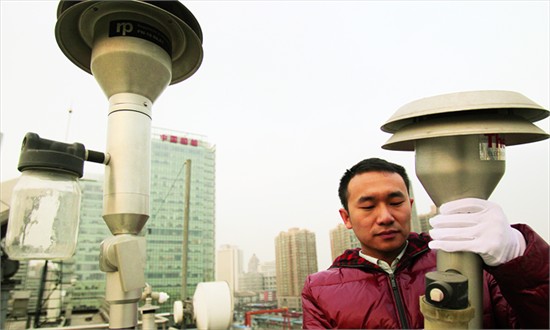
A technician installs devices that will allow the environmental authority to monitor PM2.5 data on the top of a tall building on January 6. (Photo: CFP)
An official with the Municipal Environmental Protection Bureau (EPB) said Tuesday that the location of the US embassy's air quality monitoring station is too close to pollution sources, which is part of the reason why its AQI (air quality index) readings are always higher than Beijing's official air pollution data.
"The embassy's station is about 15 meters away from the road, but a monitoring station should be at least 50 meters away from pollution sources according to international common practice," said Yu Jianhua, chief of the EPB's atmosphere section, speaking on a Beijing Public Service Radio program.
Monitoring stations should not be too close to pollution sources such as car emissions, he said, and the location should be representative, "not in the most polluted place and not the least polluted place either." It requires a lab and a professional team to do equipment maintenance and to ensure the accuracy of the data, Yu noted.
The US embassy is fairly close to the Third Ring Road, although it is not clear if this is what Yu was referring to.
"We believe that promoting clean air and environmental transparency is in the interest of all our citizens. Our data has always been publicly available," said Richard Buangan, US embassy spokesman, in an e-mail reply to the Global Times. He did not comment on the EPB official's public statement about the station's location.
The difference between air quality data from the US embassy and the EPB has been a source of increasing debate among the Chinese public.
In October last year, the embassy rated the air in Beijing as "dangerous" during especially foggy days, while the EPB's pollution index showed it was only "slightly polluted." Criticism and doubts over the EPB's data and its credibility followed, with the public urging the government to release PM2.5 data.
The center started releasing hourly updates of PM2.5 data (particulate matter smaller than 2.5 microns) from a Haidian district station on its website, bjmemc.com.cn, from January 21. Currently, only this station at Chegongzhuang Xilu releases PM2.5 data, but the bureau plans to install at least 30 stations in Beijing to provide PM2.5 data in the future, Yu said.
"The US embassy only has one monitoring station, which is in downtown Beijing, and they claim the data is for their own use only, not for public reference," Du Shaozhong, the EPB's deputy head told the Global Times.
The bureau has 27 monitoring stations citywide, and their results can reflect a city's average air quality in a scientific way, he said.
Du said in a Beijing Evening News report in November last year that the EPB is willing to compare their monitoring methods, equipment and standards with the US embassy's but the embassy refused them several times.
However, Buangan said "The US embassy's previous offer to collaborate with Beijing EPB on monitoring and data sharing still stands."
Du made no comment on this yesterday, and said he will not speak to media about Beijing's air quality anymore, without further explanation.
"We shouldn't set official data against non-governmental monitoring results as they use different methods and equipment," said Feng Yongfeng, founder of Beijing-based environmental watchdog Green Beagle.
While the official way is to get an average result, non-governmental monitoring takes a closer approach to residents' lives and surroundings, which residents care about more, he said.
"I believe the US embassy's data is true about the condition in the station's surrounding area. Civil monitoring can be a good complement to the official data," he remarked.
To get more detailed and real-time information about air quality, Feng suggested a monitoring center for each residential community, with technological support from the government, so that residents can know about the air condition near them.

Copyright ©1999-2011 Chinanews.com. All rights reserved.
Reproduction in whole or in part without permission is prohibited.